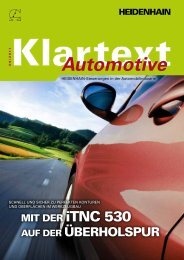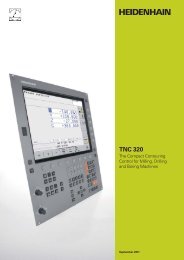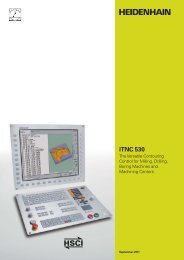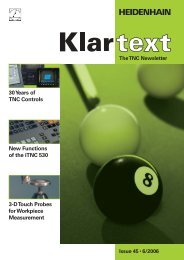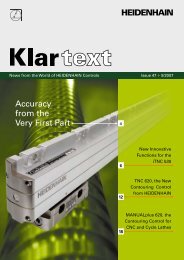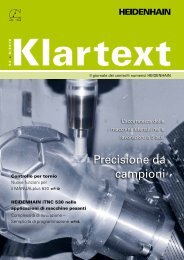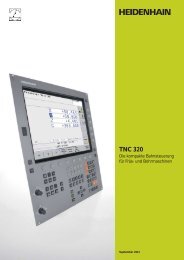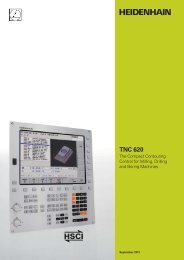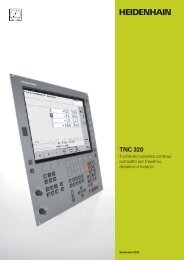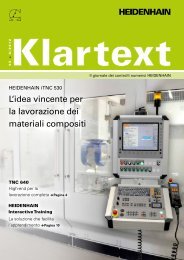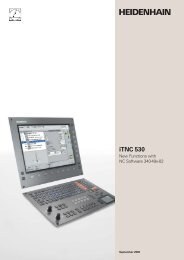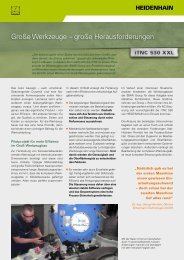iTNC 530 New Functions with NC Software 340 49x-07 - Heidenhain
iTNC 530 New Functions with NC Software 340 49x-07 - Heidenhain
iTNC 530 New Functions with NC Software 340 49x-07 - Heidenhain
Create successful ePaper yourself
Turn your PDF publications into a flip-book with our unique Google optimized e-Paper software.
<strong>iT<strong>NC</strong></strong> <strong>530</strong><br />
<strong>New</strong> <strong>Functions</strong> <strong>with</strong><br />
<strong>NC</strong> <strong>Software</strong> <strong>340</strong> <strong>49x</strong>-<strong>07</strong><br />
September 2011
<strong>New</strong> <strong>Functions</strong> <strong>with</strong> <strong>NC</strong> <strong>Software</strong> <strong>340</strong> <strong>49x</strong>-<strong>07</strong><br />
—The <strong>iT<strong>NC</strong></strong> <strong>530</strong> Makes Working <strong>with</strong> the Machine Even Easier<br />
The <strong>iT<strong>NC</strong></strong> <strong>530</strong> from HEIDENHAIN has<br />
proven itself for years as a versatile<br />
contouring control for milling, drilling and<br />
boring machines as well as machining<br />
centers. Along <strong>with</strong> HEIDENHAIN’s plainlanguage<br />
conversational programming for<br />
the shop floor, the <strong>iT<strong>NC</strong></strong> <strong>530</strong> is<br />
characterized by many useful functions<br />
and innovative features. To name just a<br />
few:<br />
• Exact tool guidance for five-axis<br />
machining<br />
• Simple tilting of the working plane<br />
• Practice-oriented setup functions<br />
• Very high contour accuracy for HSC<br />
milling<br />
• Extensive fixed cycles<br />
• Helpful programming support through<br />
unambiguous function keys, free contour<br />
programming and help graphics<br />
• Upwardly compatible part programs<br />
• External programming and fast data<br />
transfer<br />
The success story of the <strong>iT<strong>NC</strong></strong> <strong>530</strong> also<br />
includes smarT.<strong>NC</strong>—the new operating<br />
mode from HEIDENHAIN. It represents<br />
another successful step toward more userfriendliness<br />
in a shop-floor programming<br />
interface. Well-structured input forms,<br />
straightforward graphic support, and<br />
comprehensive help texts combine <strong>with</strong><br />
the easy-to-use pattern generator to form<br />
a compelling programming environment.<br />
2<br />
<strong>New</strong> functions for the <strong>iT<strong>NC</strong></strong> <strong>530</strong><br />
Of course there is always potential for<br />
new development, improvement and<br />
simplification. The <strong>NC</strong> software <strong>340</strong> <strong>49x</strong>-<strong>07</strong><br />
for the <strong>iT<strong>NC</strong></strong> <strong>530</strong> includes a series of new<br />
functions for machine tool builders and<br />
users. These functions make it even easier<br />
to work <strong>with</strong> the control, and they also<br />
make operation of the machine more safe.<br />
The most important new functions are:<br />
• smarT.<strong>NC</strong> wizard for inserting smarT.<strong>NC</strong><br />
units in conversational programs<br />
• Cycle for interpolation turning (option)<br />
• Cycle for machining 3-D contour trains<br />
• Engraving cycle<br />
Error fixes, new and improved functions<br />
and options<br />
As of <strong>NC</strong> software <strong>340</strong> <strong>49x</strong>-02, error fixes<br />
have been separated from software<br />
improvements. Updates of <strong>NC</strong> software<br />
usually contain only error fixes.<br />
<strong>New</strong> functions certainly offer added value<br />
regarding user-friendliness and operational<br />
reliability. Naturally you also have the<br />
opportunity to purchase these new<br />
functions after a software update: These<br />
new and improved functions are offered<br />
as “feature upgrades,” and are enabled via<br />
the Feature Content Level option.<br />
If, for example, a control is to be upgraded<br />
from <strong>NC</strong> software <strong>340</strong> <strong>49x</strong>-02 to <strong>340</strong> <strong>49x</strong>-<strong>07</strong>,<br />
the functions identified <strong>with</strong> “FCL xx” in<br />
the following tables are only available if the<br />
feature content level is set from 02 to 04.<br />
Of course the current feature content level<br />
also includes the upgrade functions of the<br />
previous <strong>NC</strong> software versions.<br />
All of the options included in the<br />
respective <strong>NC</strong> software can be purchased,<br />
no matter which feature content level you<br />
have.
smarT.<strong>NC</strong> Goes Conversational<br />
—Inserting smarT.<strong>NC</strong> Units in Conversational Programs<br />
The new smarT.<strong>NC</strong> wizard completely<br />
unifies the worlds of smarT.<strong>NC</strong> and<br />
conversational programming. The<br />
strengths of both worlds are now available<br />
in a single user interface. The full flexibility<br />
of conversational programming, based on<br />
<strong>NC</strong> blocks, can now be combined at any<br />
location <strong>with</strong> the fast, form-based<br />
workstep programming method of<br />
smarT.<strong>NC</strong>. Programming goes much<br />
quicker particularly in combination <strong>with</strong> the<br />
DXF converter or the graphically supported<br />
definition of any machining patterns. All<br />
other machining units available in smarT.<strong>NC</strong><br />
also simplify the creation of conversational<br />
programs.<br />
When inserting a smarT.<strong>NC</strong> unit, the T<strong>NC</strong><br />
displays the conversational program in the<br />
familiar manner on the left side of the<br />
screen. On the right side the T<strong>NC</strong> shows<br />
the smarT.<strong>NC</strong> form <strong>with</strong> the corresponding<br />
input fields specific to the respective unit.<br />
The help graphic belonging to each input<br />
field is shown in the bottom part of the<br />
screen. When the form is saved, the T<strong>NC</strong><br />
inserts all conversational blocks necessary<br />
for the defined machining operation.<br />
Changes can later be made either in the<br />
form or directly in the appropriate <strong>NC</strong> block.<br />
The operator can decide himself which<br />
method he prefers.<br />
3
The Future is Now<br />
—Graphic Selection of Contours and Contour Sections (Option)<br />
For several years now the <strong>iT<strong>NC</strong></strong> <strong>530</strong> has<br />
been able to select contours from DXF<br />
files. Now the DXF converter can also open<br />
conversational programs that were created<br />
externally in CAM systems.<br />
The DXF converter graphically displays the<br />
tool paths generated in the CAM system.<br />
You can select parts of the contour and<br />
save them as separate <strong>NC</strong> programs. This<br />
is especially helpful, for example, when<br />
you need to rework parts of contours <strong>with</strong><br />
a smaller tool, or even if you just want to<br />
rework some parts of a 3-D shape. This<br />
function saves you a trip to the CAM office,<br />
and can be performed at any time directly<br />
on the <strong>iT<strong>NC</strong></strong>.<br />
You can then machine this newly created<br />
<strong>NC</strong> program directly or in combination <strong>with</strong><br />
the T<strong>NC</strong>’s contour train cycles.<br />
4
Safe Machining<br />
— Option for Integrated Dynamic Collision Monitoring (DCM):<br />
Improvements<br />
Dynamic collision monitoring (DCM)<br />
has now proven itself on approximately<br />
4 500 machines throughout the world.<br />
Since being introduced in 2005, this<br />
function has become an increasingly<br />
important instrument in reducing costly<br />
machine downtimes and relieving the<br />
machine operator, especially when<br />
manually moving the machine axes. During<br />
manual operation, the <strong>iT<strong>NC</strong></strong> automatically<br />
reduces the speed if two collision objects<br />
come too close to each other, and issues<br />
an error message if a collision is imminent.<br />
The <strong>iT<strong>NC</strong></strong> not only monitors the permanent<br />
machine components defined by the<br />
machine tool builder, but also fixtures,<br />
tools and tool carriers.<br />
Automatic activation/deactivation of<br />
fixture situations<br />
With the new <strong>NC</strong> functions SEL FIXTURE<br />
and FIXTURE SELECTION RESET you can<br />
activate or deactivate previously saved<br />
fixture situations in automatic operation.<br />
Specific fixtures can also be activated for<br />
each <strong>NC</strong> program from pallet tables. This<br />
increases safety and reliability in<br />
automated production.<br />
Tool carrier management<br />
In order to take tool holders into account<br />
for collision monitoring, you can assign the<br />
corresponding collision body to each tool in<br />
the tool table. There is now graphic support<br />
for selection of the collision body: the T<strong>NC</strong><br />
shows a preview of the collision body to be<br />
selected.<br />
Collision monitoring for multiple task<br />
tools<br />
If you use indexed multiple task tools,<br />
the T<strong>NC</strong> now also monitors these tasks<br />
automatically and correctly, and adapts the<br />
kinematics view correspondingly.<br />
5
Machining Flexibly<br />
—Interpolation Turning (Option)<br />
In interpolation turning the cutting edge of<br />
the tool moves on a circle, <strong>with</strong> the cutting<br />
edge always oriented to the center of the<br />
circle. By varying the circle radius and the<br />
axial position, any rotationally symmetric<br />
objects can be produced in any working<br />
plane.<br />
With the new Cycle 290 INTERPOLATION<br />
TURNING, the <strong>iT<strong>NC</strong></strong> <strong>530</strong> can create a<br />
rotationally symmetric step in the active<br />
working plane, which is defi ned by the<br />
starting and end point. The center of<br />
rotation is the tool location in the working<br />
plane at the time the cycle is called. The<br />
rotational surfaces can be inclined or<br />
rounded relative to each other.<br />
This cycle can only be used for fi nishing.<br />
Roughing operations <strong>with</strong> multiple steps<br />
are not possible. The machining strategy<br />
can be chosen fl exibly: from the outside in<br />
or vice versa, and also from top to bottom<br />
or vice versa. This results in four different<br />
machining strategies, which are distributed<br />
over the four quadrants.<br />
6
—Peripheral Milling <strong>with</strong> the <strong>New</strong> Contour Train Cycle<br />
Special demands are in force during<br />
peripheral milling of cutting and bending<br />
tools, particularly for large-scale mold<br />
making for the automobile industry. The<br />
contour edges are generated by CAM<br />
systems, and as a rule do not just contain<br />
coordinates for the machining plane, but<br />
also for the tool-axis direction. Of<br />
importance here is that the cutting or<br />
bending edge does not have a constant<br />
Z height, but can vary greatly on a<br />
workpiece.<br />
The new Cycle 276 CONTOUR TRAIN 3D<br />
can machine such 3-D contours very easily.<br />
Similar to Cycle 25 CONTOUR TRAIN,<br />
which is two-dimensional, the contour to<br />
be machined must be defined in a<br />
subprogram. You specify the approach<br />
behavior, machining mode and radius<br />
compensation <strong>with</strong> Cycle 270 CONTOUR<br />
TRAIN DATA, and then call Cycle 276. The<br />
3-D contour train can be machined <strong>with</strong> or<br />
<strong>with</strong>out an infeed, depending on whether<br />
one has been defined.<br />
The 3-D contours to be machined can be<br />
created very easily if they can be loaded<br />
from existing <strong>NC</strong> programs that were<br />
generated by a postprocessor. This applies<br />
in particular if a smaller tool must be used<br />
to rework specific areas. An enhancement<br />
was implemented for this in the DXF<br />
converter, making it possible to load<br />
contours or parts of contours from<br />
conversational programs (see page 4).<br />
7
<strong>New</strong> Programming <strong>Functions</strong><br />
—Miscellaneous<br />
<strong>New</strong> engraving cycle 225<br />
The new engraving cycle 225 is a<br />
convenient method for producing texts or<br />
serial numbers. In the cycle you enter the<br />
text via a text parameter, and of course you<br />
can choose whether the text should be in a<br />
straight line or along an arc.<br />
Thread milling cycles 262, 263, 264 and<br />
267<br />
In these thread milling cycles a separate<br />
feed rate is now available for tangential<br />
entry into the thread. Particularly <strong>with</strong> small<br />
thread sizes this makes it possible to select<br />
a higher subsequent cutting feed rate,<br />
which reduces production time.<br />
KinematicsOpt cycles 451 and 452<br />
(option)<br />
Fast optimization algorithms reduce the<br />
time for measurement, as does the fact<br />
that position optimization is now performed<br />
simultaneously <strong>with</strong> angle optimization.<br />
Furthermore, the ascertained offset errors<br />
are now available as result parameters,<br />
permitting subsequent program-controlled<br />
evaluation.<br />
Global Program Settings (GS)<br />
(option)<br />
Via an additional switch in the global<br />
program settings (GS) form you can now<br />
specify whether the values traversed in the<br />
virtual axis direction should be reset upon a<br />
tool change.<br />
8
File management:<br />
Support for ZIP archives<br />
In the <strong>iT<strong>NC</strong></strong> <strong>530</strong>’s file manager you can<br />
now create ZIP archives, in order to archive<br />
files of completed jobs, for example. Of<br />
course you can also open existing archives<br />
and extract files from there.<br />
Working <strong>with</strong> pallets<br />
Selected workpieces can be hidden during<br />
tool-oriented machining in combination<br />
<strong>with</strong> the pallet table. A new keyword is<br />
available for this.<br />
Optimizations to the DXF converter<br />
(option)<br />
Summary of the most important new<br />
features of the DXF converter:<br />
• Contours and machining positions can be<br />
selected faster and <strong>with</strong> better accuracy<br />
<strong>with</strong> a capture function.<br />
• During contour selection the <strong>iT<strong>NC</strong></strong> shows<br />
the size of the smallest contained<br />
contour radius in the status bar. This<br />
smallest radius is also shown in a<br />
different color in the selected contour.<br />
That way you can tell immediately which<br />
tool can machine the contour in any<br />
case.<br />
• Preselected contours can now also be<br />
chosen in the tree view.<br />
Enhanced tool management<br />
(option)<br />
A particularly interesting function has been<br />
added to the enhanced tool management.<br />
There is now an import function for reading<br />
and exporting CSV files. CSV (commaseparated<br />
values) is a file format for the<br />
exchange of simply structured data. This<br />
function is especially useful for data<br />
exchange if you measure and calibrate your<br />
tools <strong>with</strong> external presetters. Excel can<br />
also open and save this file format.<br />
There is now also a simple possibility for<br />
deleting tool data quickly but carefully. The<br />
T<strong>NC</strong> shows the tool data to be deleted in a<br />
pop-up window, giving you the opportunity<br />
to make sure that no important data is<br />
deleted by accident.<br />
9
Overview<br />
—All Options in <strong>NC</strong> <strong>Software</strong> <strong>340</strong> <strong>49x</strong>-<strong>07</strong><br />
Option<br />
number<br />
0<br />
1<br />
2<br />
3<br />
4<br />
5<br />
6<br />
7<br />
10<br />
Option As of <strong>NC</strong><br />
software<br />
<strong>340</strong> <strong>49x</strong>-<br />
Additional axis 01 354 540-01<br />
353 904-01<br />
353 905-01<br />
367 867-01<br />
367 868-01<br />
370 291-01<br />
370 292-01<br />
370 293-01<br />
ID Comment<br />
Additional control loops 1 to 8<br />
8 <strong>Software</strong> option 1 01 367 591-01 Machining <strong>with</strong> a rotary table<br />
• Programming of cylindrical contours as if in two axes<br />
• Feed rate in mm/min<br />
Coordinate transformation<br />
• Tilting the working plane, PLANE function<br />
Interpolation<br />
• Circular in 3 axes <strong>with</strong> tilted working plane<br />
9 <strong>Software</strong> option 2 01 367 590-01 3-D machining<br />
• Particularly jerk-free path control<br />
• 3-D tool compensation through surface normal vectors<br />
• TCPM: Tool Center Point Management<br />
• Keeping the tool normal to the contour<br />
• Tool radius compensation normal to the tool direction<br />
• Manual traverse in the active tool-axis system<br />
Interpolation<br />
• Linear in 5 axes (subject to export permit)<br />
• Spline: execution of splines (3rd degree polynomial)<br />
Block processing time: 0.5 ms<br />
18 HEIDENHAIN D<strong>NC</strong> 01 526 451-01 Communication <strong>with</strong> external PC applications over COM component<br />
40 DCM Collision 02 526 452-01 Dynamic Collision Monitoring (DCM)<br />
41 Additional language 02<br />
03<br />
03<br />
03<br />
03<br />
03<br />
04<br />
04<br />
05<br />
<strong>530</strong> 184-01<br />
<strong>530</strong> 184-02<br />
<strong>530</strong> 184-03<br />
<strong>530</strong> 184-04<br />
<strong>530</strong> 184-06<br />
<strong>530</strong> 184-<strong>07</strong><br />
<strong>530</strong> 184-08<br />
<strong>530</strong> 184-09<br />
<strong>530</strong> 184-10<br />
Slovenian<br />
Slovak<br />
Latvian<br />
Norwegian<br />
Korean<br />
Estonian<br />
Turkish<br />
Romanian<br />
Lithuanian
Option<br />
number<br />
Option As of <strong>NC</strong><br />
software<br />
<strong>340</strong> <strong>49x</strong>-<br />
ID Comment<br />
42 DXF Converter 02 526 450-01 Load and convert DXF contours<br />
44 Global PGM Settings 03 576 057-01 Global program settings<br />
45 Adaptive Feed Control (AFC) 03 579 648-01 Adaptive feed control<br />
46 Python OEM Process 04 579 650-01 Python application on the <strong>iT<strong>NC</strong></strong><br />
48 KinematicsOpt 04 630 916-01 Touch probe cycles for automatic measurement of rotary axes<br />
52 KinematicsComp 05 661 879-01 Three-dimensional compensation<br />
53 Feature content level 02 529 969-01 –<br />
77 4 Additional Axes 06 634 613-01 4 additional control loops<br />
78 8 Additional Axes 06 634 614-01 8 additional control loops<br />
92 3D-ToolComp 06 679 678-01 3-D radius compensation depending on the tool’s contact angle<br />
93 Extended Tool Management 06 676 938-01 Tool management enhanced<br />
96 Advanced Spindle<br />
Interpolation<br />
<strong>07</strong> 751 653-01 Cycle for interpolation turning<br />
11
Overview<br />
—<strong>New</strong> <strong>Functions</strong> <strong>with</strong> <strong>NC</strong> <strong>Software</strong> <strong>340</strong> <strong>49x</strong><br />
Operating mode<br />
Independent of<br />
operating mode<br />
12<br />
As of <strong>NC</strong> software<br />
Standard<br />
<strong>340</strong> <strong>49x</strong>-02<br />
<strong>340</strong> <strong>49x</strong>-03<br />
FCL<br />
Option<br />
Function<br />
40 DCM: Dynamic collision monitoring (only <strong>with</strong> MC 422 B, MC 422 C)<br />
02 USB support for peripheral memory devices (memory sticks, hard disks, CD-ROMs)<br />
02 DHCP (Dynamic Host Configuration Protocol) and DNS (Domain Name System) for network<br />
settings<br />
• Freely definable tables visible also in form view<br />
• All soft keys revised<br />
41 Slovenian language<br />
• Czech user interface now <strong>with</strong> native characters<br />
• Configurable update procedure for future software updates (e.g. automatic update over USB<br />
storage devices)<br />
• Additional HR 420 functions:<br />
• Selection of the active override possible on the HR 420<br />
• Freely definable soft-key menu for machine functions<br />
• Smaller pop-up window when HR 420 is active, to improve legibility of axis positions on screen<br />
• Look-ahead can be configured via machine parameters<br />
• Calculation of dynamic load for tilting axes<br />
• Inclined tool machining <strong>with</strong> open-loop axes<br />
44 Global program settings (GS) make it possible to superimpose various coordinate transformations<br />
and settings in the Program Run operating modes<br />
45 AFC: Adaptive feed control adjusts the contouring feed rate to the spindle power<br />
03 T<strong>NC</strong>guide: The integrated help system. User information available directly on the <strong>iT<strong>NC</strong></strong> <strong>530</strong> (only<br />
<strong>with</strong> at least 256 MB RAM)<br />
41 Conversational languages in Slovak, Norwegian, Estonian, Latvian, Korean (Asian languages<br />
require at least 256 MB RAM)
Operating mode<br />
Independent of<br />
operating mode<br />
As of <strong>NC</strong> software<br />
Standard<br />
<strong>340</strong> <strong>49x</strong>-04<br />
<strong>340</strong> <strong>49x</strong>-05<br />
FCL<br />
Option<br />
Function<br />
• Expanded and completely revised file management<br />
• Automatic and manual generation of service files for faster error diagnostics<br />
• Tool-change macro for Test Run<br />
04 Graphic display of machine kinematics in the Program Run modes of operation<br />
04 3-D basic rotation light: aligning workpieces in three dimensions<br />
40 Improvements to dynamic collision monitoring (DCM):<br />
• Handwheel superimposition possible <strong>with</strong> active DCM in stopped condition<br />
• Automatic cancellation of collision protection for touch probe during tool measurement<br />
41 Turkish and Romanian languages<br />
44 Improvements in global program settings (GS): Traverse <strong>with</strong> handwheel superimposition in the<br />
active tool-axis system (virtual axis) <strong>with</strong> active TCPM<br />
45 Improvements to adaptive feed control (AFC):<br />
• Expanded status display<br />
• Resetting the reference power in the learning mode<br />
• Use of any value as control parameter over PLC<br />
46 Python OEM process: Simpler integration of OEM applications in the <strong>iT<strong>NC</strong></strong><br />
48 KinematicsOpt: Touch probe cycles for automatic measurement of rotary axes<br />
40 Improvements to dynamic collision monitoring (DCM):<br />
• Testing the program for possible collisions prior to machining<br />
• Fixture monitoring<br />
• Simplified tool-carrier management<br />
41 Lithuanian language<br />
44 Improvements to global program settings (GS)<br />
• Optimized display of input form<br />
• Handwheel superimposition can be used together <strong>with</strong> M91/M92<br />
• Coordinate transformations can be used together <strong>with</strong> M91/M92<br />
52 KinematicsComp: Three-dimensional compensation of positioning errors that are due to<br />
mechanical causes<br />
• <strong>New</strong>, additional DG 3-D position display: Distance-to-go in the tilted coordinate system<br />
• Separate preset table for pallet presets<br />
• Support of new HR 5xx handwheels<br />
• <strong>New</strong> tool management based on Python<br />
• T<strong>NC</strong>guide: Help system <strong>with</strong> improved context sensitivity<br />
• Local QL... Q-parameters and nonvolatile QR... Q-parameters<br />
13
Operating mode<br />
Independent of<br />
operating mode<br />
14<br />
As of <strong>NC</strong> software<br />
Standard<br />
<strong>340</strong> <strong>49x</strong>-06<br />
<strong>340</strong> <strong>49x</strong>-<strong>07</strong><br />
FCL<br />
Option<br />
Function<br />
92 3D-ToolComp: 3-D radius compensation depending on the tool’s contact angle<br />
• 3-D line graphics in full-screen mode<br />
• Manual operation: Compensate workpiece misalignment through rotation of the table<br />
• SPEC FCT special functions available in MDI mode<br />
44 Improvements to global program settings (GS):<br />
• Possibility of selecting of whether the value superimposed by the handwheel in the virtual axis<br />
should be reset upon a tool change<br />
• Improved limit-switch handling in conjunction <strong>with</strong> M91 positioning movements<br />
• Program-controlled setting and resetting of form entries<br />
42 Improvements to DXF data processing:<br />
• Assume contours from conversational programs<br />
• Enhanced information in the status bar<br />
• Integrated capture function<br />
93 Enhanced tool management: Import/export of tool data in CSV format (comma-separated values)
Operating mode<br />
smarT.<strong>NC</strong><br />
As of <strong>NC</strong> software<br />
Standard<br />
<strong>340</strong> <strong>49x</strong>-02<br />
<strong>340</strong> <strong>49x</strong>-03<br />
FCL<br />
Option<br />
Function<br />
42 Direct loading of contours from DXF data and saving as smarT.<strong>NC</strong> contouring programs<br />
02 Cycles for coordinate transformation introduced<br />
02 PLANE function introduced<br />
02 Contour pocket: Separate depth can be assigned for each subcontour<br />
02 Block scan <strong>with</strong> graphic support<br />
• Entry of cutting speed as alternative to the spindle shaft speed<br />
• Feed rate can also be entered as Fz (feed per tooth) or Fu (feed per revolution)<br />
• Tool data can be edited in a pop-up window during tool selection<br />
• Axis keys now also position the cursor in the forms. The I key (incremental/absolute switchover)<br />
and P key (polar/Cartesian switchover) also function for contour programming.<br />
• CUT/COPY/PASTE of one or more units<br />
• Automatic entry of workpiece blank into contour program<br />
• Incremental entry of machining positions in forms for machining units<br />
• Tooltips displayed when using the mouse<br />
42 DXF data processing:<br />
• Separation of laterally joined contour elements<br />
• Generate point files (.HP files) directly from the DXF converter<br />
03 smarT.<strong>NC</strong> editor in the Programming and Editing operating mode<br />
• Expanded and completely revised file management<br />
• Tool table shown as a fillable form<br />
03 Machining a contour pocket on a point pattern<br />
03 Individually definable positioning heights in point patterns<br />
03 Touch probe Units 408 and 409 for setting datums in the centerline of a slot or ridge<br />
03 Setting of probing parameters in a separate Unit 441<br />
03 Automatic feed rate reduction in contour pockets during full tool engagement<br />
15
Operating mode<br />
smarT.<strong>NC</strong><br />
16<br />
As of <strong>NC</strong> software<br />
Standard<br />
<strong>340</strong> <strong>49x</strong>-03<br />
<strong>340</strong> <strong>49x</strong>-04<br />
<strong>340</strong> <strong>49x</strong>-05<br />
FCL<br />
Option<br />
Function<br />
• Climb milling/up-cut milling for helical finish milling<br />
• Retraction speed for tapping <strong>with</strong> chip breaking<br />
• Ascertained workpiece misalignment can also be compensated by rotating a C axis<br />
• Zoom function in the pattern generator<br />
• Entry of stopping angle or angular step in a pitch circle definition<br />
• Unit 141, datum shift<br />
• Unit 256, machining rectangular studs<br />
• Unit 257, machining circular studs<br />
• Unit 799, program end unit<br />
• Unit 22, fine roughing: selectable machining strategy<br />
• Unit 209, tapping: definable rotational speed of retraction<br />
• Touch probe Units 412, 413, 421 and 422: Circles can be measured at either 3 or 4 points<br />
• Inline pattern definition <strong>with</strong> PATTERN DEF<br />
• Transferring data from identical, previously defined units<br />
42 DXF data processing:<br />
• Improved handling<br />
• Info box displays data on the selected element<br />
48 Units 450 and 451, KinematicsOpt: touch probe cycles for automatic measurement of rotary axes<br />
42 DXF data processing:<br />
• POLYLINE support<br />
• Selection of machining positions <strong>with</strong> the mouse, including path optimization<br />
• Unit 241, single-lip deep-hole drilling (new)<br />
48 Improvements to KinematicsOpt:<br />
• Improved logging in Cycle 450<br />
• Time savings through shortening of the probing paths<br />
• Automatic presetting<br />
• Hiding individual rotary axes<br />
• Touch probe Units 412, 413, 421 and 422: Type of positioning at clearance height can be selected<br />
• Touch probe Units 408 to 419 also write the datum to line 0 of the preset table
Operating mode<br />
smarT.<strong>NC</strong><br />
As of <strong>NC</strong> software<br />
Standard<br />
<strong>340</strong> <strong>49x</strong>-06<br />
<strong>340</strong> <strong>49x</strong>-<strong>07</strong><br />
FCL<br />
Option<br />
Function<br />
• Unit 275, trochoidal slot (new)<br />
• Unit 241, single-lip deep-hole drilling: dwell depth (new)<br />
• Unit 460, calibrate touch probe using calibration sphere (new)<br />
48 Improvements to KinematicsOpt:<br />
• Measurement of backlash possible via additional parameter<br />
• Improved support of Hirth-coupled spindle heads<br />
• Measure and compensate misalignment of a rotary axis<br />
• Unit 276, contour train 3-D (new)<br />
• Unit 225, engraving (new)<br />
• Units 262/263/264/267, thread milling: entry feed rate (new)<br />
17
Operating mode<br />
Conversational<br />
programming<br />
18<br />
As of <strong>NC</strong> software<br />
Standard<br />
<strong>340</strong> <strong>49x</strong>-02<br />
<strong>340</strong> <strong>49x</strong>-03<br />
FCL<br />
Option<br />
Function<br />
42 Direct loading of contours from DXF data and saving as conversational programs<br />
02 Cycle for global setting of touch-probe parameters<br />
02 Point filter for smoothing externally created <strong>NC</strong> programs<br />
02 3-D line graphics for verification of programs created offline<br />
02 Manual traverse in the active tool-axis system<br />
• Entry of cutting speed as alternative to the spindle shaft speed<br />
• Simplification when working <strong>with</strong> the preset table, incremental correction of preset values<br />
possible, correction of the active preset possible<br />
• Contour pockets can now contain significantly more contour elements<br />
• Consideration of an active basic rotation in manual probe cycles<br />
• Measuring log for probing cycles can now also be displayed on the screen during program<br />
interruption<br />
• FK transformation selectable as structured plain-language or linearized plain-language<br />
42 DXF data processing:<br />
• Separation of laterally joined contour elements<br />
• Generate point files (.HP files) directly from the DXF converter<br />
03 Touch probe Cycles 408 and 409 for setting datums in the centerline of a slot or ridge<br />
03 Touch-probe Cycle 4 for three-dimensional measurements. Toggle between showing the<br />
measurement results in the coordinate system of the workpiece or the machine.<br />
03 Automatic feed rate reduction in contour pockets during full tool engagement<br />
• Climb milling/up-cut milling for helical finish milling<br />
• Retraction speed for tapping <strong>with</strong> chip breaking<br />
• Ascertained workpiece misalignment can also be compensated by rotating a C axis
Operating mode<br />
Conversational<br />
programming<br />
As of <strong>NC</strong> software<br />
Standard<br />
<strong>340</strong> <strong>49x</strong>-04<br />
<strong>340</strong> <strong>49x</strong>-05<br />
<strong>340</strong> <strong>49x</strong>-06<br />
FCL<br />
Option<br />
Function<br />
• Cycle 256, machining rectangular studs<br />
• Cycle 257, machining circular studs<br />
• Cycle 22, fine roughing: selectable machining strategy<br />
• Cycle 209, tapping: definable rotational speed of retraction<br />
• Touch probe Cycles 412, 413, 421 and 422: circles can be measured at either 3 or 4 points<br />
• Special functions of smarT.<strong>NC</strong> available for conversational programming:<br />
• Defining machining patterns <strong>with</strong> PATTERN DEF<br />
• Defining cycle parameters globally <strong>with</strong> GLOBAL DEF<br />
• File management (copying, moving, deleting) from <strong>with</strong>in the <strong>NC</strong> program<br />
42 DXF data processing:<br />
• Improved handling<br />
• Info box displays data on the selected element<br />
48 KinematicsOpt: Touch probe cycles for automatic measurement of rotary axes<br />
• Cycle 241, single-lip deep-hole drilling (new)<br />
• Touch probe Cycles 412, 413, 421 and 422: Type of positioning at clearance height can be<br />
selected<br />
42 DXF data processing:<br />
• POLYLINE support<br />
• Selection of machining positions <strong>with</strong> the mouse, including path optimization<br />
• Touch probe Cycle 484 for calibrating the TT 449 infrared tool touch probe<br />
• Touch probe Cycles 408 to 419 also write the datum to line 0 of the preset table<br />
48 Improvements to KinematicsOpt:<br />
• Improved logging in Cycle 450<br />
• Time savings through shortening of the probing paths<br />
• Automatic presetting<br />
• Hiding individual rotary axes<br />
• Touch-probe Cycle 460, calibration (new)<br />
• Cycle 275, trochoidal slot (new)<br />
• Cycle 241, single-lip deep-hole drilling: dwell depth (new)<br />
• Program selection window for PGM calls (new)<br />
• PLANE function: Retraction value for tilting to position <strong>with</strong> the TURN function (new)<br />
• Q-parameter programming: Program jumps can be controlled via QS string parameters<br />
48 Improvements to KinematicsOpt:<br />
• Measurement of backlash possible via additional parameter<br />
• Improved support of Hirth-coupled spindle heads<br />
•<br />
Measure and compensate misalignment of a rotary axis<br />
19
Operating mode<br />
Conversational<br />
programming<br />
DIN/ISO<br />
Programming<br />
station<br />
<br />
<br />
<br />
<br />
<br />
<br />
<br />
As of <strong>NC</strong> software<br />
Standard<br />
<strong>340</strong> <strong>49x</strong>-<strong>07</strong><br />
<strong>340</strong> 494-02<br />
<strong>340</strong> 494-04<br />
<strong>340</strong> 494-06<br />
FCL<br />
Option<br />
*I_842 239-21*<br />
842 239-21 · 20 · 9/2011 · F&W · Printed in Germany<br />
Function<br />
• Cycle 276, contour train 3-D (new)<br />
• Cycle 225, engraving (new)<br />
• Cycles 262/263/264/267, thread milling: entry feed rate (new)<br />
96 Advanced Spindle Interpolation: Cycle 290, interpolation turning (new)<br />
• PLANE function also in possible in DIN/ISO<br />
• Virtual keyboard can be displayed <strong>with</strong> new version of the programming station<br />
• PLC program provided for optional installation (can be used to move axes)<br />
• Access to the PLC <strong>with</strong> the keyword “PLC”<br />
• All options and FCL functions are enabled<br />
• Support for Windows Vista<br />
• <strong>iT<strong>NC</strong></strong> programming station available <strong>with</strong> network license<br />
• Support for Windows 7<br />
Zum Abheften hier falzen! / Fold here for filing!



